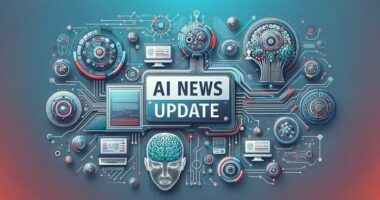Artificial intelligence is no longer only about clever algorithms or powerful GPUs—in late 2025, the story has shifted to light-speed processing, autonomous commerce, and global infrastructure transformation. Across the AI ecosystem, new technologies are emerging that not only make machines smarter but also make the entire digital world faster, cleaner, and more autonomous.
This week, three massive breakthroughs are defining the future: the arrival of optical AI chips that compute with light, the dawn of “agentic commerce” where AI systems shop on behalf of humans, and the infrastructure shake-up redefining global competitiveness.
The Arrival of Optical AI—When Light Replaces Electricity
For decades, electronic chips have powered our AI systems, but now light is taking over. At Tsinghua University, researchers recently unveiled OFE-2, a revolutionary optical processor that performs trillions of calculations per second using photons instead of electrons. This milestone means computers can now process information at the speed of light, literally.
Why It’s Revolutionary
Optical AI chips use light pulses to perform computations, drastically reducing both power consumption and processing time. In performance tests, optical circuits achieved 12.5 GHz effective throughput—a level impossible for traditional silicon.
-
Latency drop: Computation happens in nanoseconds instead of milliseconds.
-
Energy efficiency: Optical circuits reduce resistive heating, cutting energy needs by up to 90%.
-
Scalability: Because light waves can overlap without interference, multiple computations occur simultaneously.
How It Transforms AI
This advance pushes AI from high-performance data centers into real-time, mobile, and edge environments. Imagine autonomous vehicles reacting instantly or personal AI assistants running locally without cloud delays.
For enterprises, optical hardware will redefine how AI infrastructure is built. Instead of expanding GPU clusters indefinitely, companies can deploy hybrid optical-digital processors, achieving higher performance per watt. Governments and corporations are already racing to secure photonic chip supply chains.
Agentic Commerce—The New Shopping Revolution
The next big story in AI is not about content creation or chatbots—it’s about decision-making autonomy. Agentic commerce represents the next phase of consumer and business automation, where AI agents act on behalf of users to execute purchases, negotiate prices, and manage budgets.
What Is Agentic Commerce?
Agentic AI systems don’t just respond; they plan, reason, and act. These systems can handle entire workflows: identifying user needs, researching options, and completing transactions. It’s an evolution from recommendation engines to fully autonomous decision-makers.
For example, imagine a marketing manager using an AI agent to:
-
Research top-performing ad placements.
-
Negotiate ad rates using historical performance data.
-
Schedule campaigns and pay automatically.
In consumer life, AI systems like “AutoBuy” or “SmartShop AI” are already being tested. They track user behavior, predict future needs, and order groceries, tech gadgets, or even clothing before the user realizes they’re running low.
Why It’s Taking Off in 2025
Several forces converge to make this possible:
-
Model maturity: New LLMs integrate financial APIs, supply chain data, and pricing analytics.
-
Infrastructure readiness: Edge computing, optical hardware, and 6G networks enable real-time decisions.
-
Economic efficiency: Automated purchasing reduces friction in logistics and procurement chains.
The New Competition
Retailers must now compete for AI agents’ attention—not just humans’. Optimization shifts from “SEO for humans” to “AEO—Agent Engine Optimization.” The challenge is no longer making your ad visible but convincing AI algorithms that your product offers the best value.
This changes everything about digital marketing, pricing strategy, and brand identity. The brands that train AI agents to prefer them will dominate the market.
Rebuilding the Infrastructure of Intelligence
Behind every AI breakthrough lies a vast digital backbone of compute power, memory, and interconnection. According to Stanford’s HAI 2025 Index, the average cost of AI inference has dropped 280× since 2022—an unbelievable leap that redefines access to AI at scale.
A Global Infrastructure Race
-
AI Factories: Tech giants are building energy-efficient “AI factories,” massive data centers designed specifically for model training and inference. HPE’s AI Factory platform, co-developed with NVIDIA, offers governments and enterprises preconfigured stacks that combine compute, storage, and networking.
-
Optical Data Centers: New optical interconnects promise to replace copper networking inside data centers, allowing light-based transmission with minimal energy loss.
-
Edge + Cloud Synergy: As 6G matures, low-latency edge devices will complement centralized AI clouds.
Why It Matters
The countries and corporations mastering this stack—from optical hardware to edge processing—will define AI dominance. The old rule “who owns the data owns the future” is evolving into “who controls the compute defines the future.”
A New Economic Layer
AI is becoming the next layer of critical infrastructure, akin to electricity or the internet. Optical chips, energy-efficient cooling, and modular AI clusters will form the foundation of tomorrow’s smart economies.
However, this progress comes with challenges: geopolitical tensions over chip supply chains, environmental impacts of energy-hungry AI farms, and security concerns from distributed autonomous agents.
What Leaders Should Be Watching
Strategic Priorities
-
Adopt Hybrid Infrastructure: Combine optical, digital, and edge systems for balanced speed and cost.
-
Design for Autonomy: Future software must allow AI agents to act responsibly with oversight mechanisms.
-
Rethink Marketing & Sales: Adapt to agent-driven purchasing ecosystems.
Key Emerging Signals
| Trend | Why It Matters | Current Example |
|---|---|---|
| Optical AI hardware | Redefines computation speed & efficiency | Tsinghua OFE-2 prototype |
| Agentic Commerce | Turns AI into economic actors | AutoBuy & SmartShop pilots |
| AI Infrastructure 2.0 | Decides global AI competitiveness | NVIDIA–HPE AI Factory |
| Edge + Photonics integration | Enables real-time AI decisions | 6G & optical networking tests |
| Regulatory race | Shapes autonomy & transparency laws | EU AI Trust Framework 2025 |
Risks & Concerns
-
Over-Autonomy: AI systems acting unsupervised may create unforeseen market shifts or fraud loops.
-
Power Demands: Optical data centers still require huge power—sustainability remains critical.
-
Digital Divide: Nations without advanced infrastructure risk falling behind economically.
The Human Factor in a Machine World
Despite automation’s speed, human creativity remains central. The challenge isn’t competing with AI—it’s collaborating intelligently. Photonic processors will handle the heavy lifting, while humans shape goals, ethics, and meaning.
Agentic systems, if guided well, could liberate us from repetitive digital chores. Yet without governance, they risk turning commerce into algorithmic warfare.
To thrive, businesses and individuals must combine human intuition with machine precision—defining clear rules for cooperation between AI agents and human oversight.
Conclusion
As October 2025 closes, AI’s evolution toward light-speed intelligence marks the dawn of a new era. From photonic hardware accelerating computation to autonomous commerce reshaping economics, everything about how technology functions is transforming.
Tomorrow’s innovators won’t just build smarter AI—they’ll build faster, freer, and fairer systems that can think, decide, and act responsibly. The next frontier belongs to those who master light, logic, and leadership.









